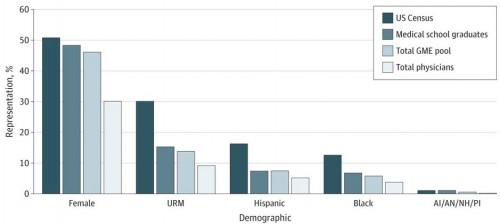It’s an online first research letter, but sometimes the best things come in small packages. “Diversity in Graduate Medical Education in the United States by Race, Ethnicity, and Sex, 2012“:
Diversification of the physician workforce in the United States remains an ongoing goal,1,2 yet assessments of graduate medical education (GME) diversity, overall and across specialties are lacking. We assessed GME diversity by race, ethnicity, and sex in 2012.
Boom! Let’s get to it.
In 2012, there were 16,835 medical graduates. Just over 48% of them were females. Just over 15% of them were from under-represented minorities. In that year, there were 115,111 trainees in graduate medical education. Just over 46% of them were females, and just under 14% of them were from under-represented minorities. How does that compare with the general population?
Females are getting close. The percentage of females graduating medical school and the percentage of them in the US population are only a few points away. But the percentage of graduates from under-represented minorities is significantly lower than the percentage those minorities make up of the US population. That’s why we call them “under-represented”.
Females were least common in orthopedics (14%) and most common in pediatrics (74%) and OB/GYN (82%). Females comprise a majority of seven specialties – OB/GYN, pediatrics, dermatology, Internal medicine/pediatrics, family medicine, pathology, and psychiatry. Black trainees were most common in OB/GYN (10%) and family medicine (8%), and Hispanic trainees were most common in psychiatry, family medicine, OB/GYN, and pediatrics (all about 9%).
For the record, I’m a Professor of Pediatrics.
This is actual data. No more assuming!


